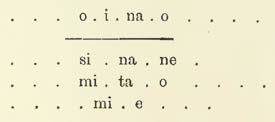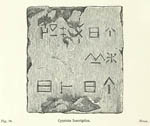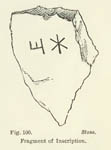Previous First Next
SALAMIS IN THE ISLAND OF CYPRUS.
BY ALEXANDER PALMA DI CESNOLÀ, F.S.A.,
page 55

translation impossible". The syllables he would read in this manner:—

In line 3 perhaps we have—ό ταμίας, "the steward", and in the fourth line ήμί, " I am". . Deecke reads u for mi in the third line, and treating the inscription as complete, sees in it:

 —From Salamis also comes a slab of calcareous stone, measuring ten inches and three-quarters in breadth, and twelve inches in height. On it (fig. 99) are three lines of Cypriote characters. The third character in line 1 has been erased or tampered with. The inscription is, howewer in other respects well cut. The reading: - —From Salamis also comes a slab of calcareous stone, measuring ten inches and three-quarters in breadth, and twelve inches in height. On it (fig. 99) are three lines of Cypriote characters. The third character in line 1 has been erased or tampered with. The inscription is, howewer in other respects well cut. The reading: -
 is not yet ascertained; perhaps, "I am (the stone) of Timokypra, (wife) of Timodamos." The rectangular character with horizontal bar, which occurs three times in this inscription and twice in (fig. 101), is a new syllable, not known to Schmidt, Deecke, or other collectors of Cypriote inscriptions. It is is not yet ascertained; perhaps, "I am (the stone) of Timokypra, (wife) of Timodamos." The rectangular character with horizontal bar, which occurs three times in this inscription and twice in (fig. 101), is a new syllable, not known to Schmidt, Deecke, or other collectors of Cypriote inscriptions. It is  taken here, conjecturally, to be equivalent to the rectangle with a vertical bar, of which the Greek transliteration is μο or μω. One of the smaller fragments of stone which.were found at Salamis (three inches long) contains (fig. 100) two Cypriote syllables "se. a." It has been conjectured by those who have a knowledge of the language that these characters may form the final part of the word Παφίας. But from the fragmentary condition of this stone, we cannot advance beyond a mere supposition. taken here, conjecturally, to be equivalent to the rectangle with a vertical bar, of which the Greek transliteration is μο or μω. One of the smaller fragments of stone which.were found at Salamis (three inches long) contains (fig. 100) two Cypriote syllables "se. a." It has been conjectured by those who have a knowledge of the language that these characters may form the final part of the word Παφίας. But from the fragmentary condition of this stone, we cannot advance beyond a mere supposition.
One of the statuettes formed of the native calcareous stone, found at Constanzia, near Salamis, bears a Cypriote inscription (fig. 101). It is ten inches and three-quarters high, and represents a female figure draped in a closely-fitting dress without many folds. Hound the neck are marks, which
Previous First Next
|